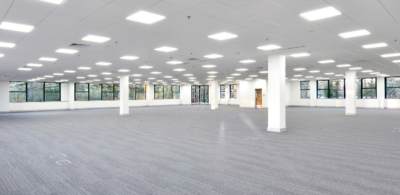We’ve all heard the motto “out of sight, out of mind,” but have you considered how this applies to office space and, specifically, renovating an office space?
Because we can’t easily see what’s above the ceiling grid, we might be tempted to disregard it altogether when making important decisions such as where to move and how much the tenant improvements might cost. The reality is that certain modifications below the ceiling grid can have a direct effect on what’s happening above — and vice versa — which could mean a substantial increase in costs.
WHAT’S ABOVE THE CEILING?
Typically, you’ll find sprinklers, light fixtures, HVAC and other complicated and essential mechanical systems above the ceiling. Each of these features can be affected by renovations or construction taking place below the ceiling grid.
For example, adding a wall might seem like a relatively simple project. You might look at it and be tempted to think, “Okay, all you need is a crew, some studs, sheetrock and boom, you’re done.” While the project might be as simple as you expect, what if that new wall interferes with the sprinkler which now has to be relocated based on engineering design? Oh, and that pesky HVAC system? It also has to be modified, which is going to be expensive.
Ultimately, that simple wall that shouldn’t cost all that much has turned out to be a costly project. Which, you guessed it, means your rent might be going up (more on that later).
Principal Chez Eider with Princeton, NJ-based U.S. National Construction puts it this way: “Landlords and tenants often look at small changes — such as adding a door, sealing up an opening to make two spaces or removing/adding a wall — as being relatively small demands in both time and money. But they often overlook the ‘domino effect’ that small changes can cause.”
WHO PAYS FOR THIS WORK?
The answer to this question really depends on your landlord and the terms of your lease. Most landlords will include these costs in their tenant improvement work letters or allowances. This doesn’t necessarily mean that all projects are going to be covered by the landlord because what might have seemed like a simple, inexpensive project when you decided to lease this space might turn into a big project. When the tenant improvement estimates exceed the allowance, the tenant will usually need to invest to make up the difference.
As an example, imagine that you fully negotiate the business terms of your lease. They include a $20-per-square-foot rental rate and a $20-per-square-foot tenant improvement allowance. You figured $20 per square foot was sufficient since the amount of work needed seemed pretty standard.
Fast forward a couple of months and you discover there’s another $10 per square foot of costs related to changes required above the ceiling grid. This situation leaves you as the tenant with only a few choices:
- You can ask the landlord to pay for it, which they may or may not do.
- You can amortize those costs into your rent.
- You can pay for it outright.
- You can develop a hybrid approach where you and the landlord share in the costs.
WHAT DOES THIS ALL MEAN?
Ultimately, this means that you should be educated and prepared when looking at space. The best way to educate yourself is by hiring a real estate advisor who knows the leasing process inside and out.
Further, you might consider hiring a broker who has the ability to provide an in-depth financial analysis of the short list of spaces you are considering. The space that needs fewer improvements but has a higher rental rate might ultimately be the more cost-effective solution compared to leasing at a cheaper rate but needing a cash infusion from the company to finish building it out.

 Colliers Insights Team
Colliers Insights Team
 Aaron Jodka
Aaron Jodka
 Amber Merrigan
Amber Merrigan
 Andrew Steele
Andrew Steele